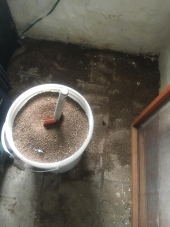
 3
3





Gardens in my mind never need water
Castles in the air never have a wet basement
Well made buildings are fractal -- equally intelligent design at every level of detail.
Bright sparks remind others that they too can dance
What I am looking for is looking for me too!

 1
1




Gardens in my mind never need water
Castles in the air never have a wet basement
Well made buildings are fractal -- equally intelligent design at every level of detail.
Bright sparks remind others that they too can dance
What I am looking for is looking for me too!


 1
1




How Permies works: https://permies.com/wiki/34193/permies-works-links-threads
My projects on Skye: The tree field, Growing and landracing, perennial polycultures, "Don't dream it - be it! "
 2
2




Mexican Marigold and Chrysanthemum contain chemicals that do more than just repel insects, they are actual insecticides that kill bugs.
Invasive plants are Earth's way of insisting we notice her medicines. Stephen Herrod Buhner
Everyone learns what works by learning what doesn't work. Stephen Herrod Buhner
 1
1




“Action on behalf of life transforms. Because the relationship between self and the world is reciprocal, it is not a question of first getting enlightened or saved and then acting. As we work to heal the earth, the earth heals us.” ~ Robin Wall Kimmerer
 3
3




 2
2




 4
4




Gardens in my mind never need water
Castles in the air never have a wet basement
Well made buildings are fractal -- equally intelligent design at every level of detail.
Bright sparks remind others that they too can dance
What I am looking for is looking for me too!

 4
4




Best luck: satisfaction
Greatest curse, greed
 2
2








Best luck: satisfaction
Greatest curse, greed
 3
3




Gardens in my mind never need water
Castles in the air never have a wet basement
Well made buildings are fractal -- equally intelligent design at every level of detail.
Bright sparks remind others that they too can dance
What I am looking for is looking for me too!

 1
1




Pearl Sutton wrote:I have a bad case of cabbage moths and squash bugs. I'm trying some odd things this year for them (like Wasp condos for cabbage moth control! )
First of all, BT is the ONLY thing that controls the ever present fungus gnats down here in Texas. I can't garden without it.
You probably have come across all of these, but I am going to go over what I found:
Trap crops: https://ipm.missouri.edu/MEG/2017/3/Trap_cropping/
looks like ground beetles and damsel bugs are natural predators to squash bugs : https://eorganic.org/node/5313
Floating row covers, straw as a mulch; and laying down cardboard or newspapers around the plants then removing them in the morning with the squash bugs attached to them underneath ( says the squash bugs congregate under the carboard/paper0 and dispose of the cardboard/newspaper; https://extension.umn.edu/fruit-and-vegetable-insects/squash-bugs
I am also seeing nasturtiums being strongly advised..and white icicle radishes...
Neem oil also works; but Neem also will destroy any insects life cycle...that includes the beneficials...
this video says to use boards to trap them: https://www.google.com/search?q=what+is+a+natural+predator+of+squash+bugs&rlz=1C1RXQR_enUS973US973&oq=what+is+a+natural+predator+of+squash+bugs&aqs=chrome..69i57.10855j0j7&sourceid=chrome&ie=UTF-8
https://drecampbell.com/natural-ways-get-rid-squash-vine-borers/
this says there's 5 insects to help control them: https://blog.bugsforgrowers.com/squash-bug/five-beneficial-insects-that-control-the-squash-bug/ (look the insects up seperately; I got a warning about the hyperlinks in the article itself; so I will post the links to the different sites for each that has information: : https://entnemdept.ufl.edu/creatures/beneficial/bigeyed_bugs.htm;
https://bugguide.net/node/view/461962/bgpage
https://texasinsects.tamu.edu/damsel-bug/
https://mdc.mo.gov/discover-nature/field-guide/feather-legged-flies
and the last one is a parasitic wasp : scelionid wasp (Gyron pennsylvanicum); all I can find is studies done at universities that still have a lot of science jargon in them..
https://academic.oup.com/ee/article/37/3/670/476624
https://homeguides.sfgate.com/kill-squash-bugs-killing-ladybugs-22177.html ; there's an idea to use hydrated lime and wood ashes here
https://growfully.com/squash-bugs/
and I saw where you can also use a shop vac with some water in the cannister to suck them up with, too. depends upon where your garden is in relation to the nearest electrical outlet and you will need a heavy duty extension cord...but hey, if it works....

 4
4




Hans Albert Quistorff, LMT projects on permies Hans Massage Qberry Farm magnet therapy gmail hquistorff




Hans Quistorff wrote:The pyrethrum family of plants protects itself from chewing insects and larva with a compound which makes them sick. Naturally it does not express this compound in a way that harms it's pollinators.
Made from the dried flowers of a little white daisy now classified as Tanacetum cinerariifolium,
Gardens in my mind never need water
Castles in the air never have a wet basement
Well made buildings are fractal -- equally intelligent design at every level of detail.
Bright sparks remind others that they too can dance
What I am looking for is looking for me too!

 2
2





Dottie Kinn
www.DottieKinn.com
 1
1




This is all just my opinion based on a flawed memory





This is all just my opinion based on a flawed memory

 3
3





|
We should throw him a surprise party. It will cheer him up. We can use this tiny ad:
Rocket Mass Heater Resources Wiki
https://permies.com/w/rmh-resources
|




